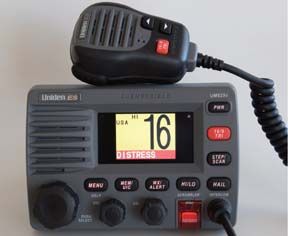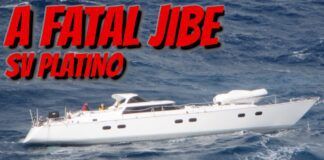
In the past year, Practical Sailor has put two-dozen fixed-mount VHF radios through their paces and selected our favorites from three different price categories. Even with coverage that extensive, one radio eluded us: the Uniden UM625c.
This recently released radio did not become available until after we went to press with the last of our three-part VHF series. With a price tag of $299 it is about $50 above the maximum price of our mid-priced radio group and just hits the minimum price we assigned for our high-end VHF radio test. In that evaluation, the Icom M602 earned a top pick and the Standard Horizon Quantum GX2360S received our Best Buy rating. (This rating system was changed recently, with Budget Buy generally replacing Best Buy, with slightly more emphasis on price.)
Could the new radio from Uniden supplant either of these two — or both? That’s what we aimed to find out. We also thought it made sense to compare the UM625c to its sibling, the UM525, which earned Best Buy in the mid-priced test.
We ran the Uniden UM625c through the same series of bench tests we’ve used for past VHF articles. Our first assessment was a string of transmitter power output tests. Keep in mind that FCC regulations prohibit more than 25 watts of power output from a marine VHF transmitter and also require a low-power setting, typically 1 watt, for harbor use. Transmitter power measurements were taken directly off the radio antenna port for all power tests.
In our first test, we used an Astron VS-70M variable voltage power supply to produce 13.8 volts DC to simulate operations in a boat with the engine running and the alternator powering the electrical system. Radio frequency (RF) power output, frequency accuracy, and power usage was recorded using a Ramsey COM3010 communications service monitor and a Fluke 336 clamp-on ammeter. On channel 16 at room temperature (75 F), the UM625c put out 20.3 watts while drawing 4.9 amps — that’s about average when compared to the others. A quick press of the HI/LO button shifts the transmitter to low power, where we measured .94 watts at 1.4 amps. Next, we stepped down the voltage to 11 volts DC to simulate trying to transmit with a weak battery. The Uniden still managed to put out 18.2 watts while drawing 4.9 amps — again, comparable to other VHF radios. If the voltage dips below 11 — as it did when we set up the test — the UM625c warns you with both an aural and visual low-battery message.
Temperature extremes were next. To cool things off, we put the radio in a bait freezer (at 15 F) for four hours. To hit the high-temperature limit, we used a fish smoker as an environmental chamber and warmed things up (122 F) for two hours. After each extreme, we tested transmitter power output again.
Frequency accuracy is defined as the ability of the transmitter to send signals on the selected frequency. Regulations mandate an accuracy of 10 parts per million, which equates to about 1550 hertz in the marine band.
Industry groups typically call for half that error or five parts per million. This is the specification on the UM625c. We measured the frequency accuracy during every transmitter test and recorded results. Our frequency stability rating, which is transmitter frequency accuracy over its entire temperature operating range, was well within specifications, though not perfect. We rated it Good.
Reminder: Inferior boat wiring, corroded electrical connections, long antenna cable runs, and numerous other factors could limit the actual radio frequency power emitted from the antenna.
Receiver sensitivity is the ability of the radio’s receiver section to hear a weak signal. Typical marine VHF receiver sensitivity ratings run from .22 to .35 microvolts, with industry groups recommending a minimum .50. The UM625c has a sensitivity specification of .25 microvolts.
The Uniden tested as advertised and earned an Excellent rating. It has more than enough sensitivity to pick up very weak incoming signals.

Another receiver standard is called selectivity. It is the ability of the receiver to reproduce only the signals transmitting on your selected channel and not signals on other nearby channels even though the latter may be very strong and close by. Our test equipment did not allow us to test for this characteristic. Instead the manufacturer provided us with a selectivity specification of 80 dB — a very high number ranked with the best radios we’ve reviewed.
Boats can be noisy places, so it is important that a marine VHF radio reproduce incoming voice signals well. Like most other VHF radios, the UM625c does this with an internal audio amplifier and speaker. To rate the audio system, we measured the sound pressure levels at maximum volume while inputting a 1 KHz tone generated by our COM3010. The measurement was taken at a distance of 1 meter using a Radio Shack decibel meter set to record dBA. The UM625c hit 90, about the same as the Uniden UM525, but well below the Icom or Standard Horizon. Our tester also rated the audio system by monitoring a weather channel. The quality of sound reproduction was rated acceptable, the same as all the other radios.
The Value Added Feature list on the UM625c is impressive. This unit has a 25-watt hailer with automatic and manual foghorn capability, sophisticated digital selective calling (DSC) capabilities, local/distant receiver settings, and an easy-to-access menu. It’s also the first VHF radio with a color display.
The UM625c has a two-zone hailer system, meaning it can be connected to a pair of hailer horns and operate each independently or together. Automatic or manual foghorn signals for a variety of conditions are selectable through the menu. We tested the hailer by connecting the radio to a Speco SPC-40RP/4 PA Trumpet Horn. All functions worked as outlined in the owner’s manual. To actually use the hailer/foghorn aboard a vessel requires the purchase and installation of a PA horn matched to the radio.
The UM625c DSC capabilities are listed in the accompanying table and are on par with the best tested. The Uniden UM625c uses the same case and super-sized front panel as the less expensive UM525.
Pushbuttons are big, backlit, and well spaced. The 1-7/8”x1-3/8” color display screen has 15 levels of backlighting and two color palettes, selectable manually or automatically. When appropriate, it displays a transmit icon, alpha channel display, and channel comments all in large, easy-to-read letters and numbers. When connected to a GPS, it will display latitude, longitude, time, course, and speed in text or a graphical format. We rated the screen Excellent.
Operating the UM625c is easy. Manual channel selection is made with a large rotary knob located in the lower left corner of the radio faceplate. This knob also serves as the enter key for certain menu operations. Volume and squelch are controlled with a pair of smaller knobs. Eight dedicated pushbuttons provide quick 16/9 channel selection, on/off power, scan, hail, transmitter power high or low, weather, memory/channel bank, and menu. We found the menu on the UM625c easy to use. Pressing the menu key selects the menu list. Rotating and pressing the channel knob chooses and completes menu actions.
Conclusion
No question, the Uniden UM625c is a top-shelf fixed-mount VHF radio. It has excellent overall transceiver performance, a ton of features, and certainly breaks new ground with its color display. In our opinion, however, all this is not enough to push the high-end winner off its pedestal. The Icom M602 remains our top pick in a high-end VHF radio. The Uniden UM625c does however snatch the high-end Budget Buy rating from the Standard Horizon Quantum GX2360S. The Standard still earns our recommendation, but the UM625c is a few bucks cheaper and loaded with extra features.
Thriftier boat owners should seriously consider sacrificing the color screen (it’s cool but not necessary), save $100, and go with our mid-priced Budget Buy, the Uniden UM525.
Also With This Article
“Value Guide: VHF Radio Comparison”
Contacts
• Icom, 425/454-7619, www.icomamerica.com
• Uniden, 800/297-1023, www.uniden.com
• Standard Horizon, 714/827-7600, www.standardhorizon.com







































